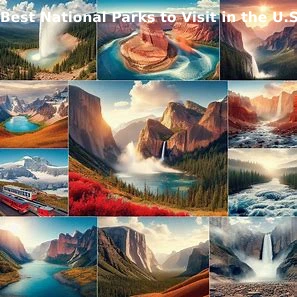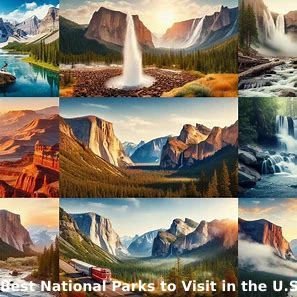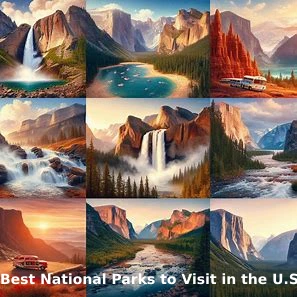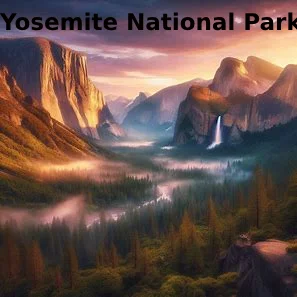Exploring the natural beauty of the United States is a journey like no other. The country boasts a diverse range of national parks, each offering unique landscapes, wildlife, and experiences. Whether you’re an adventure seeker, a nature lover, or someone looking to escape the hustle and bustle of city life, there’s a national park waiting for you.
In this guide, we’ll explore some of the best national parks to visit in the U.S., providing insights into what makes each one special and tips to make the most of your visit.
Yellowstone National Park
Yellowstone, established in 1872, is not only the first national park in the U.S. but also the first in the world. Spanning across Wyoming, Montana, and Idaho, it covers over 2 million acres of diverse landscapes.
Highlights
- Geysers and Hot Springs: Home to the famous Old Faithful geyser and the vibrant Grand Prismatic Spring.
- Wildlife: Inhabitants include grizzly bears, wolves, bison, and elk.
- Grand Canyon of the Yellowstone: Features stunning waterfalls and breathtaking views.
Tips for Visiting
- Best Time to Visit: Late spring to early fall offers the most accessible weather.
- Lodging: Book accommodations well in advance, especially during peak seasons.
- Activities: Consider guided tours to enhance your experience and ensure safety.
Yosemite National Park
Located in California’s Sierra Nevada mountains, Yosemite is renowned for its majestic waterfalls, giant sequoia trees, and impressive granite cliffs like El Capitan and Half Dome.
Highlights
- Yosemite Valley: Offers iconic views and is a hub for visitors.
- Glacier Point: Provides panoramic vistas of the park.
- Mariposa Grove: Home to over 500 mature giant sequoias.
Tips for Visiting
- Best Time to Visit: Spring for waterfalls; summer for hiking; fall for fewer crowds.
- Permits: Some hikes, like Half Dome, require permits. Plan accordingly.
- Transportation: Utilize the park’s shuttle system to reduce traffic and parking issues.

Grand Canyon National Park
One of the most iconic natural wonders in the world, the Grand Canyon in Arizona offers awe-inspiring views, hiking trails, and rafting opportunities along the Colorado River.
Highlights
- South Rim: Most accessible with numerous viewpoints and facilities.
- North Rim: Offers a more secluded experience but is less accessible.
- Bright Angel Trail: A popular trail that descends into the canyon.
Tips for Visiting
- Best Time to Visit: Spring and fall for milder temperatures and fewer crowds.
- Safety: Stay hydrated and be prepared for temperature changes.
- Reservations: Lodging and camping spots fill up quickly; reserve in advance.
Zion National Park
Located in Utah, Zion is known for its towering sandstone cliffs, narrow slot canyons, and rich biodiversity.
Highlights
- Angels Landing: A challenging hike with rewarding views.
- The Narrows: A hike through the narrowest section of Zion Canyon.
- Wildlife: Keep an eye out for mule deer, bighorn sheep, and various bird species.
Tips for Visiting
- Best Time to Visit: Spring and fall for pleasant weather and wildflowers.
- Shuttle System: The park operates a shuttle to reduce traffic; use it to access popular areas.
- Permits: Some hikes require permits; check in advance.
Glacier National Park
Situated in Montana, Glacier National Park boasts over 700 miles of hiking trails, pristine lakes, and, as the name suggests, glaciers.
Highlights
- Going-to-the-Sun Road: A scenic drive offering breathtaking views.
- Lake McDonald: The largest lake in the park, perfect for boating and photography.
- Wildlife: Home to mountain goats, grizzly bears, and moose.
Tips for Visiting
- Best Time to Visit: July to September when roads and facilities are fully open.
- Hiking: Be bear-aware; carry bear spray and know how to use it.
- Lodging: Limited within the park; consider nearby towns for accommodations.
Here is a detailed article on Yosemite National Park.
Acadia National Park
Located on the coast of Maine, Acadia offers a unique blend of oceanic and mountainous landscapes.
Highlights
- Cadillac Mountain: One of the first places in the U.S. to see the sunrise.
- Jordan Pond: Known for its clear waters and the famous Jordan Pond House.
- Carriage Roads: 45 miles of rustic roads ideal for biking and walking.
Tips for Visiting
- Best Time to Visit: Fall for vibrant foliage; summer for warmer temperatures.
- Reservations: Vehicle reservations are required for Cadillac Summit Road during peak season.
- Activities: Explore tide pools during low tide for a unique experience.
Great Smoky Mountains National Park
Straddling the border between North Carolina and Tennessee, this parkoffers lush forests, mist-covered mountains, and diverse wildlife. It’s one of the most visited national parks in the U.S.
Highlights
- Clingmans Dome: The highest point in the park with stunning panoramic views.
- Cades Cove: A scenic valley rich in history, wildlife, and hiking opportunities.
- Roaring Fork Motor Nature Trail: A picturesque drive through the forest.
Tips for Visiting
- Best Time to Visit: Spring for wildflowers and fall for vibrant foliage.
- Hiking: Popular trails like Alum Cave and Laurel Falls are great for families.
- Wildlife: Be cautious of black bears and other wildlife; maintain a safe distance.
Tips for Visiting National Parks
Plan Ahead
- Research the park’s rules, weather, and seasonal highlights. Many parks require permits for specific activities or areas.
- Book accommodations or campsites in advance, especially during peak seasons.
Pack Essentials
- Bring appropriate clothing, sturdy footwear, and plenty of water.
- Carry maps, sunscreen, and a first-aid kit for safety.
Practice Leave No Trace
- Keep the parks clean by carrying out all trash.
- Avoid disturbing wildlife and stick to designated trails to protect natural habitats.
Check Weather Conditions
- Weather can change quickly, especially in mountainous or remote areas.
- Always check the forecast before heading out and plan accordingly.

FAQs about National Parks
1. Which national park is the most visited in the U.S.?
Great Smoky Mountains National Park consistently ranks as the most visited, thanks to its accessibility and stunning beauty.
2. What’s the best time to visit national parks?
The ideal time varies by park. Generally, spring and fall offer pleasant weather and fewer crowds, while summer is perfect for families.
3. Do I need a pass to enter national parks?
Yes, most parks require an entrance fee or an annual pass like the “America the Beautiful” pass, which covers multiple parks.
4. Can I bring pets to national parks?
Some parks allow pets in designated areas, but restrictions are common. Check the park’s website for specific rules.
5. Are national parks accessible for people with disabilities?
Many parks offer accessible trails, facilities, and programs. Look for accessibility information on the park’s official website.
Final Words
Exploring the best national parks in the U.S. is an unforgettable experience. Whether you’re marveling at geysers in Yellowstone, hiking in Zion, or soaking up the coastal views in Acadia, these parks offer something for everyone. Respect nature, plan your trip thoughtfully, and take the time to enjoy the beauty and serenity that each park provides.
Start planning your adventure today and discover the wonders that await in America’s great outdoors!


